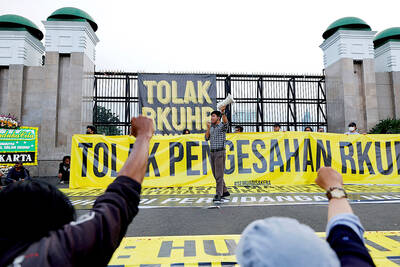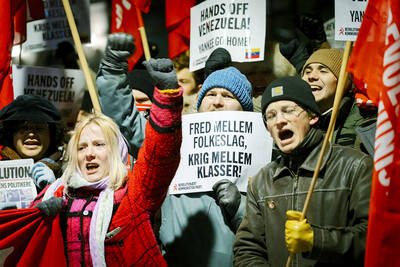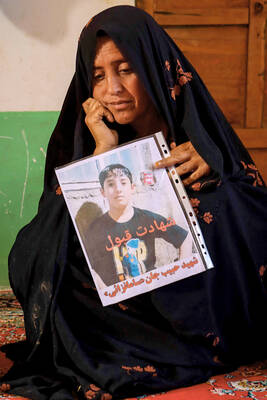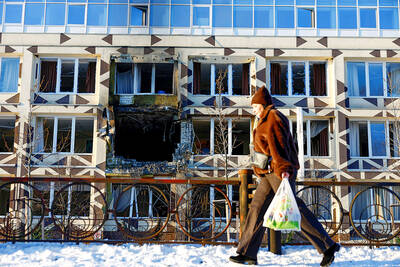Brazilians tired of corruption are organizing street protests through online social networks, a movement likely to gain strength after a government minister resigned this week under a cloud of suspicion.
The non-partisan protest organizers plan to hold a new march on Tuesday in Rio de Janeiro to highlight the scandals rocking the government of Brazilian President Dilma Rousseff.
An initial protest held in Brasilia on Sept. 7, Brazil’s Independence Day, gathered 30,000 people, many of them wearing red clown noses.
Cristian Maza, one of the movement founders said that the web initiative calling for the protests “snowballed” after she and friends copied messages seen on Facebook and repeated them on their own digital walls.
Thirty thousand people have already signed on to say they will attend the Rio rally.
“Several demonstrations are being organized. We hope that will make things change,” said Maza, a 37-year-old shopkeeper. “This won’t be fixed with just one march. The cry has to continue.”
The usual tolerance of Brazilians for corruption has been tested in recent months with revelations that have caused a number of departures from Rousseff’s government.
Brazilian Tourism Minister Pedro Novais was forced to step down on Wednesday after suspicions were raised about the embezzlement of millions of US dollars. Reports also said Novais paid a personal assistant with public funds and his wife used a parliamentary aide as her personal chauffeur.
Novais was the latest departure from Rousseff’s government, following the agriculture, transport and chief ministers who also became embroiled in scandals suggesting personal enrichment at taxpayers’ expense.
The incidents have badly weakened the image of Rousseff and her government.
Former Brazilian minister of defense Nelson Jobim was forced to resign last month not because of corruption charges, but because he openly criticized other cabinet members.
Some analysts have said that the exits showed Rousseff was demanding higher standards from her ministers than those set under her predecessor and mentor for Brazilian president Luiz Inacio Lula da Silva.
“The degree of tolerance by the president to these corruption claims is less than those shown by Lula and other presidents, who protected the fingered politicians,” said Gil Castello Branco, secretary-general of Contas Abertas, a group calling for government accountability and transparency.
Brazilian society, at the same time, is putting up with less, too, he said.
“On rare occasions, the Brazilian people mobilize and that is what is happening now. We hope this cleaning up of politics continues,” he said.
However, political analyst Everaldo Moraes said that an anti-corruption sweep had its limits, if only because the coalition government had to ensure it could keep ruling.
“Rousseff is looking to reassure public opinion, to show she won’t accept corruption, but at the same time trying not to blow up its relationship with its allies,” he said.
According to another group, Transparencia Brasil, Brazil’s federal system means that a high number of public officials are in positions to pocket public money.
The Brazilian government has around 60,000 officials at that level, compared to 9,000 in the US. It also has to watch over 27 states and 5,000 municipalities.
Rousseff, a 63-year-old former guerrilla who trained as an economist, took power in January at the head of a government made up of nine parties.
A recent study by the Getulio Vargas Foundation, a Brazilian university, estimated that between 2002 and 2008 corruption cost the country the equivalent of US$23 billion.

Indonesia yesterday began enforcing its newly ratified penal code, replacing a Dutch-era criminal law that had governed the country for more than 80 years and marking a major shift in its legal landscape. Since proclaiming independence in 1945, the Southeast Asian country had continued to operate under a colonial framework widely criticized as outdated and misaligned with Indonesia’s social values. Efforts to revise the code stalled for decades as lawmakers debated how to balance human rights, religious norms and local traditions in the world’s most populous Muslim-majority nation. The 345-page Indonesian Penal Code, known as the KUHP, was passed in 2022. It

‘DISRESPECTFUL’: Katie Miller, the wife of Trump’s most influential adviser, drew ire by posting an image of Greenland in the colors of the US flag, captioning it ‘SOON’ US President Donald Trump on Sunday doubled down on his claim that Greenland should become part of the US, despite calls by the Danish prime minister to stop “threatening” the territory. Washington’s military intervention in Venezuela has reignited fears for Greenland, which Trump has repeatedly said he wants to annex, given its strategic location in the arctic. While aboard Air Force One en route to Washington, Trump reiterated the goal. “We need Greenland from the standpoint of national security, and Denmark is not going to be able to do it,” he said in response to a reporter’s question. “We’ll worry about Greenland in

PERILOUS JOURNEY: Over just a matter of days last month, about 1,600 Afghans who were at risk of perishing due to the cold weather were rescued in the mountains Habibullah set off from his home in western Afghanistan determined to find work in Iran, only for the 15-year-old to freeze to death while walking across the mountainous frontier. “He was forced to go, to bring food for the family,” his mother, Mah Jan, said at her mud home in Ghunjan village. “We have no food to eat, we have no clothes to wear. The house in which I live has no electricity, no water. I have no proper window, nothing to burn for heating,” she added, clutching a photograph of her son. Habibullah was one of at least 18 migrants who died

Russia early yesterday bombarded Ukraine, killing two people in the Kyiv region, authorities said on the eve of a diplomatic summit in France. A nationwide siren was issued just after midnight, while Ukraine’s military said air defenses were operating in several places. In the capital, a private medical facility caught fire as a result of the Russian strikes, killing one person and wounding three others, the State Emergency Service of Kyiv said. It released images of rescuers removing people on stretchers from a gutted building. Another pre-dawn attack on the neighboring city of Fastiv killed one man in his 70s, Kyiv Governor Mykola